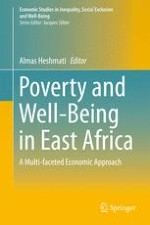2016 | OriginalPaper | Chapter
8. Evaluation of Redistributive and Welfare Impacts of Indirect Taxes Reform in Rwanda
Authors : Etienne Ndemezo, Francis Menjo Baye
Published in: Poverty and Well-Being in East Africa
Publisher: Springer International Publishing
Activate our intelligent search to find suitable subject content or patents.
Select sections of text to find matching patents with Artificial Intelligence. powered by
Select sections of text to find additional relevant content using AI-assisted search. powered by
